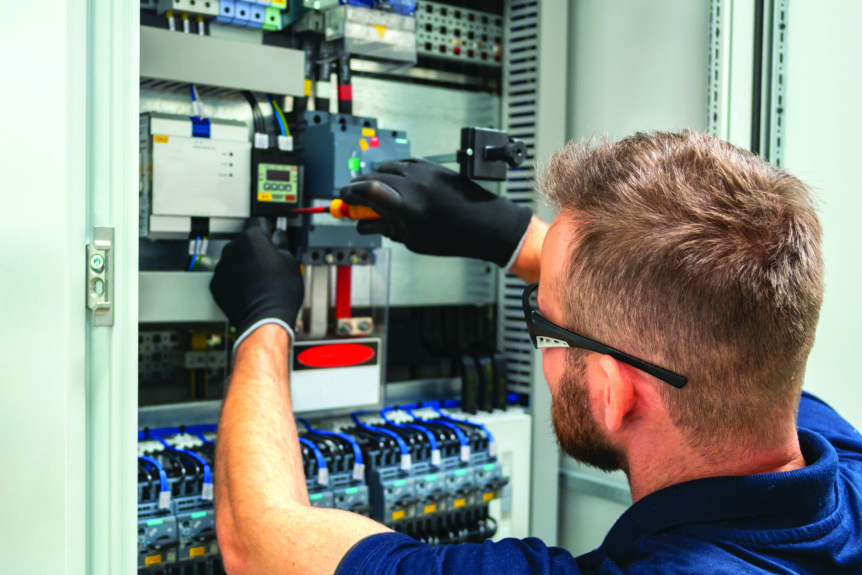As the electrical industry addresses arc flash electrical safety concerns, it now acknowledges the high risks associated with what used to be normal maintenance tasks. In many cases, excessively high arc flash incident energy levels require all maintenance to be done with equipment de-energized, despite the fact that it may not always be considered feasible.
In addition to the usual electrical safety concerns, technicians in the field must be concerned with a myriad of other things. One such safety concern is employee health. Personal protective equipment (PPE) in many cases is not designed or intended to be shared among employees. In order to safely share or re-issue certain types of PPE, a company must follow manufacturer and OSHA cleaning, sanitizing, and tracking procedures. Doing so can also help prevent the spread of illnesses like the common cold, hepatitis, influenza, and SARS-Cov2 (Covid-19). Employees should also be trained to properly clean and maintain their individually issued PPE.
Using new system designs, products, retrofits, equipment modifications, and alternate protection settings can significantly lower arc flash incident energy levels and employee risk. In many cases, NFPA 70E PPE Category 2 or lower can be obtained using these tools and techniques.
Reducing Incident Energy
One of the most convenient methods to lower the incident energy — which will in turn lower an employee’s potential exposure during a fault of electrical equipment — is to enable the equipment to clear the fault quicker and associated protective devices to trip faster. The following are just some of the methods to reduce the clearing time of an electrical fault using various protective devices and schemes.
1. Use fuses, current-limiting fuses, and current-limiting breakers to reduce the amount of incident energy released during arc flashes by reducing the amount of available fault current.
2. Use current-limiting reactors, which restrict fault current levels. For example, low-voltage motor control centers can be supplied with three single-phase reactors that limit available short circuit current, resulting in smaller energy releases when faults occur.
3. Implement a bus differential scheme that increases the speed to trip the circuit, which will reduce the arc flash hazard. The concept of a bus differential protection (87B) scheme has been around for a very long time, but because of space and cost constraints, it was typically only applied on medium- to high-voltage equipment. The scheme measures 100% of the current going into and out of a bus. It requires three additional current transformers on every breaker. Simply put:
If 100% IIN = 100% IOUT, then no trip
If 100% IIN ≠ 100% IOUT, then trip all bus breakers instantaneously
4. Use zone selective interlocking (ZSI) to improve downstream coordination so more zones can be attained with selective tripping. ZSI is a control logic system that communicates between feeder breakers and upstream breakers. The control system is built into the electronic and digital trip units of low-voltage breakers. ZSI’s use and design have improved significantly over the last 20-plus years.
Assuming a high-level short circuit occurs on the load side of a feeder breaker, both the main breaker and the feeder breaker’s digital trip units sense the fault. The feeder breaker sends a blocking signal to the main breaker letting it know that the fault is in its zone of protection. The blocking signal tells the main breaker to only trip per the trip unit’s time- delayed standard settings (backup to the feeder breakers) while the feeder breaker is the first to clear the fault.
When a fault occurs in the switchgear on the primary side of a feeder breaker, no blocking signal is sent to the main breaker. Since the main breaker senses the fault but does not receive a blocking signal, its control logic bypasses the selective coordination time delays and trips instantly. It lowers its time-delay settings to approximately 2 cycles, providing just enough delay to assure nuisance tripping does not occur.
When applying ZSI as an arc-flash solution, be aware of the following:
A. It is automatic and requires no special precautions.
B. It will only affect the short time delay and ground fault time delay setting characteristics.
C. The arcing fault current must be above the short time pickup settings (STPU) or ground fault pickup (GFPU) settings for ZSI to be initiated, thus reducing the arc-flash incident energy.
D. Different breaker testing procedures will be required during maintenance and calibration testing to prove the integrity of the system.
5. Apply a maintenance switch, which is another effective way to lower arc flash incident energy level. This option can be retrofitted onto older equipment or purchased new in low- and medium-voltage protective devices. An external override switch and circuitry is connected to a breaker’s trip unit and adjusted to between 2.5X–10X. The intent of the maintenance switch is to lower incident energy at downstream protective devices. The maintenance switch is closed when performing maintenance. This automatically overrides all the associated breaker’s delay functions and causes the breaker to trip without any intentional delay when a fault is detected. When maintenance is complete, the maintenance switch is manually reopened and all previous trip unit settings are reactivated without need for recalibration.
6. Install arc detection sensors provide a clear measurement of an arc flash. The light emitted during an arc flash event is significantly brighter than normal substation background light. The light surge is available from the initiation of the arc flash and is easily detected using existing technology.
The most commonly found sensors are lens point and bare fiber optic. The light is channeled from the sensor to the detector located in the protective relay. System integrity is monitored using a fiber optic loop. In the case of lens sensors, each lens has an input and output connection. The input is connected to a transmitter in the relay, and the output is connected to a detector in the relay. This loop connection allows periodic testing of the system by injecting light from the transmitter through the loop and back to the detector. This loop connection system works with either sensor type.
The bare fiber sensor consists of a high-quality plastic fiber optic cable without a jacket. The clear fiber cable becomes a lens, bringing in light from the area. Using a bare fiber sensor makes detection in large areas possible using only one sensor. The cable is constructed of a 1-millimeter plastic material that can withstand a 25-millimeter bending radius without damage. The cable can be cut to length in the field and fit to the application without excess cable.
Most arc detection systems use a combination of lens and bare fiber sensors returning to a single relay. Proper installation of the sensors and relays provides logical detection and trip points in the system. Sensors should be located where arc detection for the specific sensor would trip the corresponding upstream breaker. Using more than one sensor provides 100% coverage even during 1-millisecond testing intervals. Installation of sensors varies depending on the switchgear manufacturer, type of gear, and number of sections. Multiple sensor inputs provide coverage and sectioning options. One bare fiber sensor can provide excellent coverage of the entire bus section. Using lens sensors allows better control in smaller, more confined spaces.
One obstacle to using light sensors is the need to measure and adjust for changing ambient light levels. Measuring light and current in the protective relay can use the analog measurements and event-reporting capabilities in the relay. By monitoring the incoming light as an analog signal, the end-user can view and set the normal light levels for the application. Event reporting also provides a troubleshooting tool with time-tagged events, including arc sensor light levels. Tracking arc light intensity provides the detail needed to reach the root cause of an event. The added advantage of processing arc flash detection in the protective relay is the ability to use a true overcurrent measurement as a supervising element to improve security.
To achieve the fastest trip times, some arc detection systems use a current setting level below the normal expected load. This enables the arc flash detector as the trip mechanism. Using current in this manner removes any time lag determining whether a fault exists, but it sacrifices selectivity and makes the system dependent on light detection alone. Superior security can be obtained using a high-speed overcurrent element in conjunction with the light sensor without sacrificing trip speeds.
A true high-speed overcurrent element is used in parallel with an arc flash detector. The current used to trigger a trip is derived by sampling the feeder current and using a fast detection algorithm to signal that a fault has occurred. This fault is then compared with the trip levels of the arc detection sensors to determine if an arc flash trip is warranted. Many standard overcurrent elements have response times between 6 and 20 milliseconds; however, this delay is unacceptable for arc flash detection supervision. To avoid introducing additional delay, the high-speed overcurrent protection must act as quickly as the arc detector. The combination of fast overcurrent and arc flash detection must be present at the same instant; the combined security is much higher than either system alone. Adding arc flash sensors reduces the total fault-clearing time, and the time reduction has a dramatic effect on arc flash energy.
These are just some of the technologies and methods to reduce arc flash energy in electrical switchgear. Compliance with arc flash hazard work rules as defined by OSHA, NFPA 70E, Standard for Electrical Safety in the Workplace and NFPA 70, National Electrical Code requires evaluation of arc flash hazards and subsequent posting of the incident energy level on the electrical equipment. New in 2020 to NFPA 70 are Article 240.67(C) and Article 240.87(C) requiring performance testing:
The arc energy reduction protection system shall be performance tested by primary current injection testing or another approved method when first installed on site. This testing shall be conducted by a qualified person(s) in accordance with the manufacturer’s instructions.
A written record of this testing shall be made and shall be available to the authority having jurisdiction.
Informational Note: Some energy reduction protection systems cannot be tested using a test process of primary current injection due to either the protection method being damaged such as with the use of fuse technology or because current is not the primary method of arc detection.
Conclusion
All methods described above require proper maintenance of the associated electrical systems and the arc energy reduction protection system. De-energizing equipment before performing any work is always the safest way, but it is not always feasible. When you must work on any equipment, energized or not, ensure you wear the appropriate personal protective equipment (PPE) to perform the task.
 Scott Blizard has been the Vice President and Chief Operating Officer of American Electrical Testing Co., Inc. since 2000. During his tenure, Scott also acted as the Corporate Safety Officer for nine years. He has over 25 years of experience in the field as a Master Electrician, Journeyman, Wireman, and NETA Level IV Senior Technician.
Scott Blizard has been the Vice President and Chief Operating Officer of American Electrical Testing Co., Inc. since 2000. During his tenure, Scott also acted as the Corporate Safety Officer for nine years. He has over 25 years of experience in the field as a Master Electrician, Journeyman, Wireman, and NETA Level IV Senior Technician.
